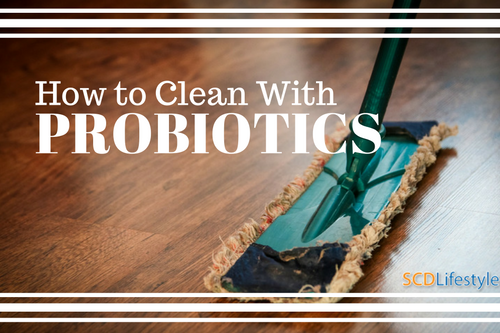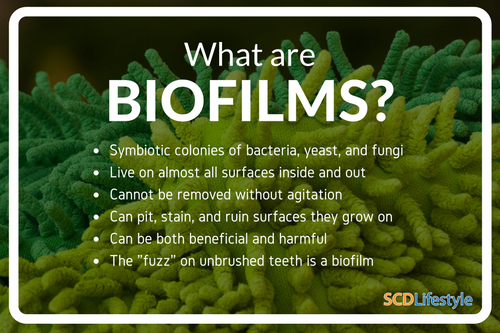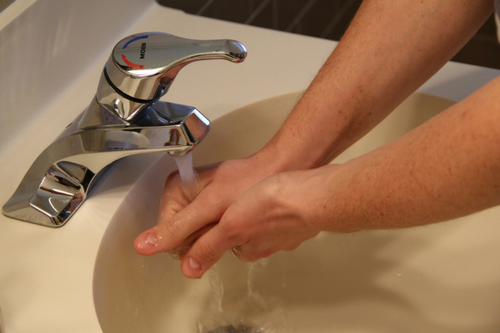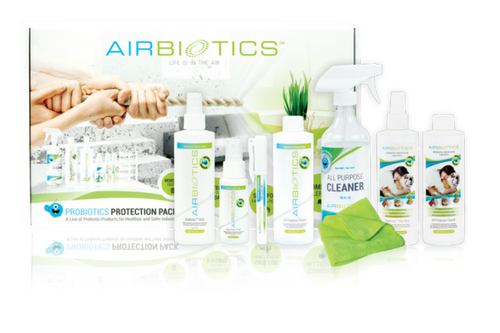How To Clean Your House With Probiotics

The five-second rule is a lie.
It turns out, if you drop something on the floor, no matter how fast you pick it up, it’s still dirty. This was confirmed by a study recently conducted by two Rutgers University professors called “Is the five-second rule real?”
If you’re like me, I bet you occasionally employ the five-second rule. After all, my house is clean! But after reading this study – and hearing the lead scientist admit he wouldn’t eat food dropped on his own kitchen floor – I had to reconsider how clean my house truly was.
Yes, I clean regularly. But like most people – regularly could probably stand to happen a bit more often. And because of concerns for my health and the health of our planet, I stopped using chemical cleaning products years ago. Without resorting to harsh chemical cleaners or constant vigilance, I wondered – What would I have to do to make my house clean enough to literally eat off the floor?
Biofilms: Are They Making Your House Dirty?
You know that sticky, fuzzy, yucky feeling you get on your teeth if you go too long between brushing? Some people say it’s like their teeth are wearing sweaters. Those sweaters are actually something called biofilm.
Biofilm is made up of tons of different strains of bacteria that have come together to live in one symbiotic colony. The bacteria cells stick together and form a surface of slime. The biofilm acts as a protective home for bacteria, yeast, fungi, and other microorganisms.
Biofilm isn’t just on your teeth – it actually grows just about everywhere – including all over your home. One very common type of biofilm commonly grows in bathrooms and is pink – you may have seen this growing in your shower or toilet bowl and wondered if it was mold. This biofilm is called S. marcescens and despite the pretty color, it isn’t harmless. It can infect open wounds in humans and your urinary tract – not very comforting if you see it in your toilet!
In natural environments, biofilms are a very important part of the ecosystem. In my house, however, they are an unwelcome visitor.
The Dangers of Conventional Cleaning Products
If your reaction to learning what that pink stuff in your toilet is was to dump a cup of bleach in the bowl, I have some more bad news.
Conventional cleaning products not only are dangerous to your health and the health of everyone else in your home (kids, plants, animals) – they also aren’t always effective at removing biofilms.
Think about it this way: what gets your teeth more clean – swishing with mouthwash or getting in a thorough brush? We all know the answer is brushing.
And just as with the biofilm on your teeth, to clean the biofilm in your house you need more than just a spray of chemicals, as chemicals like bleach or ammonia aren’t able to penetrate the biofilm to kill all bacteria.
In fact, there are 4 properties of biofilms that make them tougher than a normal cleaning job to handle :
- Biofilms can stain and mar the surface of your household items – like your toilet, fridge, and counters. In some instances, these items are ruined and must be replaced.
- Biofilms grow and spread easily
- They are almost impossible to remove without physically disrupting the biofilm (by scrubbing)
- Biofilm protects the bacteria living in it – making it harder to kill and remove
If you want a shot at removing the biofilm, even with something harsh like bleach, you’ll also need to put in some elbow grease and scrub to disrupt the biofilm. But scrubbing with bleach or other harsh chemicals drastically increases your contact with the chemicals – it can get in your eyes, on your skin, and can be inhaled into your lungs.
And trust me – you do not want to prolong your exposure to traditional cleaning products. Some of the most common products – like Lysol Multi-Purpose Cleaner – score an “F” rating from the Environmental Working Group, a non-profit environmental research group. This is due to ingredients like sodium borate, which can cause birth defects and damage to the reproductive system.
Even so-called ‘green” cleaners are often not any better. Green Works All-Purpose cleaner also scores an “F” from the EWG. Its high levels of preservatives are linked to cancer and respiratory effects.
Harsh Cleaners Aren’t Only Under Your Sink
Keeping your house clean isn’t the only place you’re potentially being exposed to really harmful chemicals. After you’re done scrubbing your toilet with Lysol, you need to wash your hands, right?
Cleaners that are designed to come into contact with your skin – like hand sanitizer or antibacterial soap – can be just as dangerous. Just this year, the Food and Drug Administration finally banned the antibacterial triclosan from soap. Not only did the FDA find triclosan to be ineffective (plain soap and water work just as well) – but it is also thought to be contributing to the rise of antibiotic resistant bacteria. It also has been linked in animal studies to immune system stimulation and thyroid problems.
But the catch is – while triclosan must now be removed from hand and body soap for consumers – it is still allowed in hand sanitizers, wipes, and hospital settings. This means you’re likely still being exposed.
If you’re like me, you probably use hand sanitizer more often than you actually wash your hands..
Healthier Cleaning Alternatives – But What About the Biofilm?
For years, instead of chemical cleaners I’ve relied on plain soap, water, and a little help from vinegar and baking soda to keep my house clean.
Generally, this works really well.
But remember that pink biofilm, S. marcescens, I was talking about before? Well, a few months ago I noticed something pink in my shower – and despite my industrious scrubbing and vinegar-spraying, it just kept coming back.
I didn’t want to spend tons of time scrubbing and cleaning my shower – but I also wanted the biofilm gone. Although I knew I wouldn’t go back to bleach, I decided to look for a natural cleaner that was effective for biofilms. So, what was the safe cleaner I found that wiped out biofilms? It’s something you’ve heard of before (and probably use daily): probiotics.
Probiotics for Your House?
It’s kind of hard to remember a time when every grocery and vitamin store didn’t have a huge probiotic section, isn’t it?
But just 10 years ago, probiotics weren’t mainstream. Luckily, a lot has changed since then – and with good reason. Probiotics are friendly strands of bacteria that support the native bacteria in our digestive system – and that is really important because our body is made up of 10x more bacteria than the cells.
I’ve made probiotics a regular part of my life, both those that come in a capsule and from potent fermented foods like homemade yogurt and sauerkraut.
But in doing research, I came across something totally new – the idea that you can use external probiotics to clean and make your indoor environments healthier and safer.
Yes, you read that right; probiotics are now being used to balance indoor air and clean surfaces like kitchens, bathrooms, and even on furniture. Cleaners containing live probiotics are able to work their way through the biofilm and clean deeply.
If this sounds crazy to you, just remember that 10 years ago the idea of taking a daily probiotic capsule was pretty “out there.”
How Do External Probiotics Benefit You?
I think of traditional antibacterial cleaners like antibiotics for my house.
We all know that when you’re sick and take antibiotics, nearly all the bacteria in your gut is wiped out – both the good and the bad. If you take those antibiotics for too long, the bacteria in your gut can become really unbalanced. The result can be gut dysbiosis – where the “bad” bacteria overrun the good bacteria that keep them in check.
When you effectively use chemical cleaners in your house (meaning you scrub to disrupt the biofilm), almost all the bacteria is wiped out too – both the good and the bad. Just like in your body, this makes your house more susceptible to an overgrowth of bad bacteria.
Repeated use of antibacterial soaps and cleaners – which decimate good and bad bacteria – contributes to the evolution of antibiotic-resistant super-bugs like MRSA. Just like in our bodies, we don’t want to wipe out all the bacteria in our house if we can avoid it – we just want to get rid of the bad stuff.
A Biofilm-Busting Alternative
A few months ago, I found out about a new external probiotic cleaner – it’s called Airbiotics. I tried out their 3 main products in my home: Airbiotics All-Purpose Cleaner, StaBiotic Mist, and their hand cleanser.
I was interested in trying them because they’re all non-toxic, fragrance and alcohol free, biodegradable – and food-grade! This means if I spray it on my counter and then set food there – it’s ok! If my dog licks something I’ve used the cleaner on, he won’t get sick. Most cleaners – even green cleaners – are toxic if ingested and loaded with fragrances that irritate my lungs, but Airbiotics products aren’t.
I use the All-Purpose cleaner on just about every surface in my house – woods, granite, glass, mirrors, and porcelain tile. Since I use it for just about everything, I’m really glad that the bottle is refillable – the cleaner comes as a concentrate you mix up yourself. This means you can make as much or as little as you need and cuts down on the cost as well as the impact on the environment.
I loved how easy it was to use (just spray and wipe with a microfiber cloth) and there’s no smell or residue.
And what about that pink biofilm in my bathroom?
The All-Purpose cleaner wiped it out!
The best part is this cleaner continues to clean for 3-5 days after it’s sprayed, thanks to the probiotics it contains. I think of them as my own army of minions, working overtime to keep my house clean so I can relax and enjoy other things.
Airbiotics also makes a really nifty hand cleanser – I keep one in my backpack and one in my car – it’s totally unlike any hand cleanser I’ve ever used. It isn’t sticky, oily, stinky or drying – after you spray it on your hands and rub it in, it’s like nothing was ever there. In reality, what’s left are tons of probiotics that help to keep your hands clean and healthy – even if you wash later with soap and water.
My favorite product, however, is the StaBiotic Mist. I think of it as the healthy alternative to Febreeze. Rather than putting fake odors into the air that give an illusion of “freshness,” you can spray the StaBiotic Mist on anything that is upholstered (read: difficult to clean). The probiotics in the StaBiotic mist consume the bacteria that produce odor. I used it on my bed, my dog’s bed, a musty chair, curtains and throw pillows, and rather than just masking the smell or covering it, it actually got rid of it.
It not only freshens and gets rid of odors – but the StaBiotic Mist’s active probiotics literally eat dust mite proteins. Using the mist has reduced my indoor allergy symptoms like congestion and red eyes. The StaBiotic Mist is a totally one-of-a-kind product that I love.
Clean At What Cost?
Chemical cleaning ingredients are expensive.
Pre-made green products are even more expensive.
My vinegar and baking soda routine was cheap and easy. I knew I wasn’t going to trade it in for an expensive, inconvenient solution.
Airbiotics doesn’t just clean my house more effectively by using probiotics, it is also really affordable. The cost of the All-Purpose Cleaner is cup-for-cup less than bleach.
Buying the All-Purpose Cleaner concentrated means I need to order less often and save on shipping, too.
Why Am I Talking About Airbiotics?
The team here at SCD Lifestyle is committed to pursuing the best health – through diet and through lifestyle. That’s why, when we come across a product as unique and beneficial as Airbiotics, we want to share with the people we love most – our community.
Airbiotics doesn’t just clean your house safely and affordably – it works to keep your house clean and promotes your wellness through one of our favorite things ever – probiotics!
I’ve incorporated Airbiotics into my natural cleaning routine and I couldn’t be happier. If you want to try Airbiotics too, you can use this link to try them out and receive 30% off your first order!
Questions? Cleaning tips for me? Let me know in the comments below.
– Steve
Did You Like this Article?
Subscribe to our newsletter to receive email notifications, some ways to find relief, and next steps.



